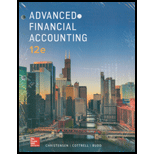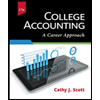
ADVANCED FINANCIAL ACCT.(LL) >CUSTOM<
12th Edition
ISBN: 9781260824292
Author: Christensen
Publisher: MCGRAW-HILL HIGHER EDUCATION
expand_more
expand_more
format_list_bulleted
Question
Chapter 19, Problem 19.15Q
To determine
Introduction : Voluntary health and welfare organizations (VHWOs) provide a variety of social services. These organizations withdrawn funds from the community in large amount and typically provide services with a nominal amount to those with the ability to pay or free of cost to those who cannot pay. The federal government generally provides tax exempted status to these organizations.
How do VHWOs account for donated services?
Expert Solution & Answer
Want to see the full answer?
Check out a sample textbook solution
Students have asked these similar questions
I need help finding the correct solution to this financial accounting problem with valid methods.
Can you solve this general accounting problem using appropriate accounting principles?
Please provide the correct answer to this financial accounting problem using accurate calculations.
Chapter 19 Solutions
ADVANCED FINANCIAL ACCT.(LL) >CUSTOM<
Ch. 19 - Prob. 19.1QCh. 19 - Prob. 19.2QCh. 19 - Prob. 19.3QCh. 19 - Prob. 19.4QCh. 19 - Prob. 19.5QCh. 19 - Prob. 19.6QCh. 19 - Prob. 19.7QCh. 19 - Prob. 19.8QCh. 19 - Prob. 19.9QCh. 19 - Prob. 19.10Q
Ch. 19 - Prob. 19.11QCh. 19 - Prob. 19.12QCh. 19 - Prob. 19.13QCh. 19 - Prob. 19.14QCh. 19 - Prob. 19.15QCh. 19 - Prob. 19.16QCh. 19 - Prob. 19.17QCh. 19 - Prob. 19.18QCh. 19 - Should a rotary club, an ONPO, report depreciation...Ch. 19 - Prob. 19.20QCh. 19 - Prob. 19.1CCh. 19 - Prob. 19.2CCh. 19 - Prob. 19.3CCh. 19 - Prob. 19.4CCh. 19 - Prob. 19.5CCh. 19 - Prob. 19.7CCh. 19 - Prob. 19.1.1ECh. 19 - Prob. 19.1.2ECh. 19 - Prob. 19.1.3ECh. 19 - Prob. 19.1.4ECh. 19 - Prob. 19.1.5ECh. 19 - Prob. 19.1.6ECh. 19 - Prob. 19.2.1ECh. 19 - Prob. 19.2.2ECh. 19 - Prob. 19.2.3ECh. 19 - Prob. 19.2.4ECh. 19 - Prob. 19.2.5ECh. 19 - Prob. 19.2.6ECh. 19 - Prob. 19.2.7ECh. 19 - Prob. 19.2.8ECh. 19 - Prob. 19.2.9ECh. 19 - Prob. 19.2.10ECh. 19 - Prob. 19.2.11ECh. 19 - Prob. 19.2.12ECh. 19 - Prob. 19.3ECh. 19 - Prob. 19.4ECh. 19 - Prob. 19.5.1ECh. 19 - Prob. 19.5.2ECh. 19 - Prob. 19.5.3ECh. 19 - Prob. 19.5.4ECh. 19 - Prob. 19.5.5ECh. 19 - Prob. 19.5.6ECh. 19 - Prob. 19.5.7ECh. 19 - Prob. 19.5.8ECh. 19 - Prob. 19.5.9ECh. 19 - Prob. 19.6ECh. 19 - Prob. 19.7ECh. 19 - Prob. 19.8.1ECh. 19 - Prob. 19.8.2ECh. 19 - Prob. 19.8.3ECh. 19 - Prob. 19.8.4ECh. 19 - Prob. 19.8.5ECh. 19 - Prob. 19.8.6ECh. 19 - Prob. 19.8.7ECh. 19 - Prob. 19.8.8ECh. 19 - Prob. 19.8.9ECh. 19 - Prob. 19.8.10ECh. 19 - Prob. 19.9ECh. 19 - Prob. 19.10PCh. 19 - Prob. 19.11PCh. 19 - Prob. 19.12PCh. 19 - Prob. 19.13PCh. 19 - Prob. 19.14PCh. 19 - Prob. 19.15PCh. 19 - Prob. 19.16PCh. 19 - Prob. 19.17PCh. 19 - Prob. 19.18PCh. 19 - Prob. 19.19PCh. 19 - Prob. 19.20PCh. 19 - Prob. 19.21PCh. 19 - Prob. 19.22PCh. 19 - Prob. 19.23PCh. 19 - Prob. 19.24.1PCh. 19 - Prob. 19.24.2PCh. 19 - Prob. 19.24.3PCh. 19 - Prob. 19.24.4PCh. 19 - Prob. 19.24.5PCh. 19 - Prob. 19.24.6PCh. 19 - Prob. 19.24.7PCh. 19 - Prob. 19.24.8PCh. 19 - Prob. 19.24.9PCh. 19 - Prob. 19.24.10PCh. 19 - Prob. 19.24.11PCh. 19 - Prob. 19.24.12PCh. 19 - Prob. 19.24.13PCh. 19 - Prob. 19.24.14PCh. 19 - Prob. 19.24.15PCh. 19 - Prob. 19.24.16PCh. 19 - Prob. 19.24.17PCh. 19 - Prob. 19.24.18PCh. 19 - Prob. 19.24.19PCh. 19 - Prob. 19.24.20PCh. 19 - Prob. 19.25PCh. 19 - Prob. 19.26P
Knowledge Booster
Similar questions
- Please explain the solution to this general accounting problem using the correct accounting principles.arrow_forwardI am looking for the correct answer to this general accounting question with appropriate explanations.arrow_forwardCan you help me solve this general accounting problem with the correct methodology?arrow_forward
- Baxter Solutions has sales of $1,480,000, costs of $710,000, depreciation expenses of $95,000, and interest expenses of $40,000. The company is subject to a 28% tax rate. a. Calculate the net income for the firm. b. If the company paid out $100,000 in cash dividends, calculate the increase to retained earnings.arrow_forwardA company sells a product for $75 per unit. Variable costs are $45 per unit, and fixed costs total $180,000 per year. How many units must be sold to achieve a target profit of $120,000? Give answerarrow_forwardgeneral accountingarrow_forward
arrow_back_ios
SEE MORE QUESTIONS
arrow_forward_ios
Recommended textbooks for you
 EBK CONTEMPORARY FINANCIAL MANAGEMENTFinanceISBN:9781337514835Author:MOYERPublisher:CENGAGE LEARNING - CONSIGNMENT
EBK CONTEMPORARY FINANCIAL MANAGEMENTFinanceISBN:9781337514835Author:MOYERPublisher:CENGAGE LEARNING - CONSIGNMENT Accounting Information SystemsAccountingISBN:9781337619202Author:Hall, James A.Publisher:Cengage Learning,
Accounting Information SystemsAccountingISBN:9781337619202Author:Hall, James A.Publisher:Cengage Learning, College Accounting (Book Only): A Career ApproachAccountingISBN:9781337280570Author:Scott, Cathy J.Publisher:South-Western College Pub
College Accounting (Book Only): A Career ApproachAccountingISBN:9781337280570Author:Scott, Cathy J.Publisher:South-Western College Pub

EBK CONTEMPORARY FINANCIAL MANAGEMENT
Finance
ISBN:9781337514835
Author:MOYER
Publisher:CENGAGE LEARNING - CONSIGNMENT

Accounting Information Systems
Accounting
ISBN:9781337619202
Author:Hall, James A.
Publisher:Cengage Learning,




College Accounting (Book Only): A Career Approach
Accounting
ISBN:9781337280570
Author:Scott, Cathy J.
Publisher:South-Western College Pub